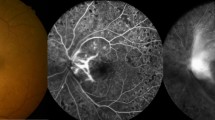Abstract
Purpose
To report a case of familial exudative vitreoretinopathy (FEVR) rapidly resolved by intravitreal injection of bevacizumab.
Methods
A 36-year-old woman complained about floaters and visual field defect. Funduscopic examinations revealed retinal vessel anastomosis located between the equator and ora serrata in both eyes. The right eye was accompanied with slight vitreous hemorrhage. Since the patient declined retinal cryopexy for cosmetic reasons, intravitreal bevacizumab injections (1.25 mg/0.05 ml) were performed in both eyes.
Results
Treatment resulted in the rapid regression and the accelerated fibrosis of neovascular tissues. At 4-month follow-up in the right eye and 1-month follow-up in the left, no signs of systemic or ocular complications were detected.
Conclusions
Intravitreal injection of bevacizumab may be considered as an alternative method in treating FEVR.


Similar content being viewed by others
References
Criswick VG, Schepens CL (1969) Familial exudative vitreoretinopathy. Am J Ophthalmol 68:578–594
van Nouhuys CE (1989) Juvenile retinal detachment as a complicaton of familial exudative vitreoretinopathy. Fortschr Ophthalmol 86:221–223
Mintz-Hittner HA, Kuffel RR Jr (2008) Intravitreal bevacizumab(Avastin) treatment of stage 3 retinopathy of prematurity in zone Ior posterior zone II. Retina 28(6):831–838, doi:10.1097/IAE.0b013e318177f934
Bashshur ZF, Bazarbachi A, Schakal A, Haddad ZA, El Haibi CP, Noureddin BN (2006) Intravitreal bevacizumab for the management of choroidal neovascularization in age-related macular degeneration. Am J Ophthalmol 142:1–9, doi:10.1016/j.ajo.2006.02.037
Iturralde D, Spaide RF, Meyerle CB (2006) Intravitreal bevacizumab(Avastin) treatment of macula edema in central retinal vein occulusion: a short-term study. Retina 26:279–284, doi:10.1097/00006982-200603000-00005
Spaide RF, Fisher YL (2006) Intravitreal bevacizumab(Avastin) treatment of proliferative diabetic retinopathy complicated by vitreous hemorrhage. Retina 26:275–278, doi:10.1097/00006982-200603000-00004
Honda S, Hirabayashi H, Tsukahara Y et al (2008) Acute contraction of the proliferative membrane after an intravitreal injection of bevacizumab for advanced retinopathy of prematurity. Graefes Arch Clin Exp Ophthalmol 246(7):1061–1063, doi:10.1007/s00417-008-0786-7
Author information
Authors and Affiliations
Corresponding author
Rights and permissions
About this article
Cite this article
Tagami, M., Kusuhara, S., Honda, S. et al. Rapid regression of retinal hemorrhage and neovascularization in a case of familial exudative vitreoretinopathy treated with intravitreal bevacizumab. Graefes Arch Clin Exp Ophthalmol 246, 1787–1789 (2008). https://doi.org/10.1007/s00417-008-0949-6
Received:
Revised:
Accepted:
Published:
Issue Date:
DOI: https://doi.org/10.1007/s00417-008-0949-6




